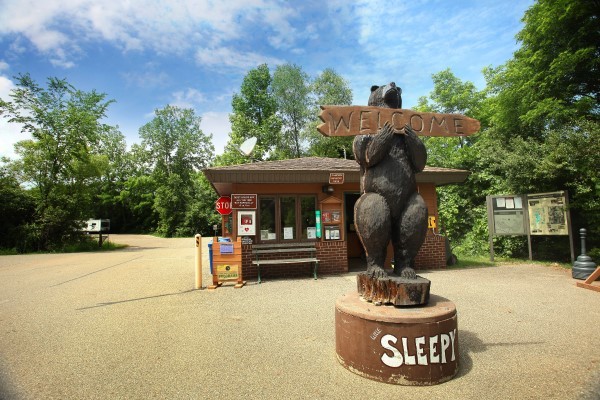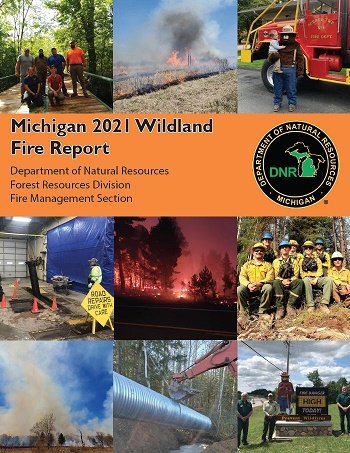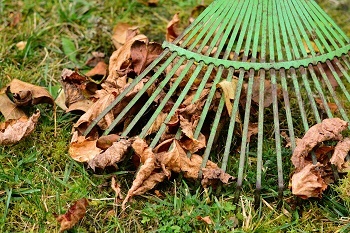|
Here are just a few of this week's stories from the Michigan Department of Natural Resources:
See other news releases, Showcasing the DNR stories, photos and other resources at Michigan.gov/DNRPressRoom.
PHOTO FOLDER: Larger, higher-res versions of the images used below, and others, are available in this folder.
 Want to see more pictures like this, taken by Michigan state parks photo ambassador Mike Sonnenberg at Sleepy Hollow State Park in Clinton County? Visit Instagram.com/MiStateParks to explore photos and learn more about the photo ambassadors! For more on the photo ambassador program, call Stephanie Yancer at 989-274-6182.

Canada geese are a common sight on Michigan's waters. In fact, they nest in every Michigan county, but are most common in the southern third of the state. You may even see and hear Canada geese all year in some parts of the state.
In June and July, these birds often are found on lakes and golf course ponds, feeding on lush lawns while molting – the annual loss of their flight feathers, which takes about two weeks. Canada geese are unable to fly during molting, so putting up a temporary barrier between your yard and the water may help keep flightless geese away from your property. Geese are especially attracted to lawns that are heavily fertilized, watered and mowed.
"If you live on a lake and geese frequently visit your yard, try making your lawn less attractive to them by allowing your grass to grow long and cutting down on fertilizer and water, or try planting shrubs to create a barrier between your lawn and the water," said Barbara Avers, waterfowl and wetland specialist with the DNR.
Intentionally feeding Canada geese can attract them to the area as well, so don’t – especially if you are having conflicts with geese. Such artificial feeding can make them comfortable around people; it also can increase overcrowding and potentially spread disease among the birds.
|
"You may also want to use scare tactics to frighten them away without harming them," said Avers. "Use a combination of loud noises such as shell crackers, bird alarms or bird bangers, distress cries, screamers and electronic noise systems, along with visual deterrents like bird scare balloons, Mylar scare tape and plastic flags."
Additional information on how to handle conflicts with geese, including population control options that require a permit, is available at Michigan.gov/Wildlife.
Canada goose hunting season dates and bag limits can be found in the current Waterfowl Hunting Digest at Michigan.gov/Waterfowl.
Questions about goose conflicts or goose hunting? Contact the DNR Wildlife Division at 517-284-9453.

Step, stride and snatch up trash during the summer Adopt-a-Forest challenge, the week between World Environment Day (June 5) and Get Outdoors Day (June 11). We want to see how far Adopt-a-Forest can take us!
Summer is a great time to trade the gym for the great outdoors and lend a hand while you’re at it. Volunteers are key to keeping the forests we love clean and beautiful, helping to protect nature and wildlife.
|

To join, organize your volunteer team, clean up a forest area in need of help and tell us how many steps or miles it took the team to clean up the dump site. Record your steps using a fitness tracker, pedometer or your phone’s health app. When you’re out on a cleanup site, make sure to wear sturdy boots, gloves and outdoor gear appropriate for the weather.
As a thank-you, we’ll send the first 100 volunteers a Smokey Bear buff to show off their outdoor pride this summer. You can wear this multi-functional wrap as a headband, bandana, neck gaiter or in many other ways.
|
How to get stepping
- Visit Michigan.gov/AdoptaForest to volunteer.
- Find dumpsites in your area using the Adopt-a-Forest dumpsite database.
- Head out to the forest and clean a dumpsite.
- Report cleanup information through the dumpsite database.
- Send steps taken/distance walked, a mailing address and any photos of your accomplishment to DNR-CleanForests@Michigan.gov.
Questions? Contact program coordinator Conor Haenni, 989-429-5542.

Widely known as a “living fossil of the Great Lakes,” the lake sturgeon is a big part of Michigan fishing lore. Don’t miss the chance to learn more about the species – and have a lot of fun – at The Friends of the St. Clair River’s 9th annual Blue Water Sturgeon Festival.
Open from 10 a.m. to 3 p.m. Saturday, June 4, at Lighthouse Park in Port Huron, the festival celebrates this gentle, prehistoric giant, a mascot for Great Lakes recovery. From the 1800s, lake sturgeon declined in the Great Lakes due to habitat loss and degradation and overfishing. Since the early 2000s, federal, state and tribal agencies have partnered in rehabilitating lake sturgeon.
For nine years now, thousands of people have gathered on shore each June to mark the migration of the sturgeon that return to the Blue Water area to spawn. Festivalgoers can enjoy a live sturgeon touch tank, hands-on activities, dozens of vendor booths, workshops, Native American drum ceremonies, hand-release of baby sturgeon, food trucks, live music and more. You can even “adopt a sturgeon” that scientists have tagged and are tracking in the wild.
At the festival, passengers can board the Huron Lady Sturgeon Cruise and experience a rare, close encounter with lake sturgeon underneath the Blue Water Bridge. The one-hour, narrated cruise takes riders on the St. Clair River and Lake Huron to interact with biologists who are catching, tagging and releasing the fish. The cruise sets off at 11 a.m. and tickets are $30. Festival admission is free.
Get full festival details at SturgeonFestival.com.
|

When smoke and flickering flames blaze across the landscape, red trucks with flashing lights and teams of DNR firefighters are close behind. Wildland firefighters arrive at the scene of hundreds of wildfires each year, ready to protect. Units battled 274 fires that burned 2,379 acres of land in 2021.
While 574 homes, businesses and structures were threatened, just 20 were destroyed – all outbuildings.
“We place a priority on saving homes whenever possible,” said DNR state fire supervisor Dan Laux. “Our firefighters are proud to defend their neighbors and communities from harm.”
The annual DNR wildland fire report shares further details on the 2021 fire season, including fire prevention efforts, fire causes and more. (It's useful information for 2022, too; halfway through this year, DNR crews already have fought more than 140 wildfires!)
A key takeaway: the No. 1 cause of fires for 2021 again was yard debris burning, starting 34% of fires.
“It’s disappointing that debris burning, a preventable fire cause, continues to top the list every year,” said DNR fire prevention specialist Paul Rogers. “Safe burning saves lives. Don’t burn on a windy day, stay near your fire and always have a water source nearby.”
|

Instead of burning, consider other means of brush and leaf disposal such as chipping or composting.
Other major fire causes were escaped campfires (10%), power lines (9%) and equipment (8%). Equipment can cause fires when sparks from machinery ignite dry leaves, or when hot equipment brushes over long grass. Most fires, at 80%, originated on private property.
In addition to fighting fires, staff made improvements to forest roads, removed hazardous trees, assisted with forest health work and conducted 57 carefully planned prescribed burns to renew the landscape.
Prescribed burns are conducted to set back invasive plants and renew fire-dependent forest and grassland ecosystems. Burns benefit species such as turkeys and pheasants, the endangered Karner blue butterfly and the Kirtland’s warbler.
Learn about wildland firefighting and fire safety at Michigan.gov/FireManagement.
|
|